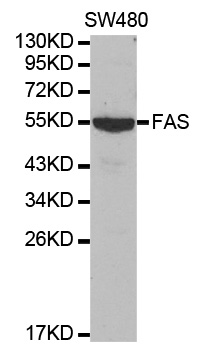CD95 (FAS) Rabbit Polyclonal Antibody
USD 200.00
USD 867.00
USD 436.00
Specifications
| Product Data | |
| Applications | WB |
| Recommended Dilution | WB 1:500 - 1:2000 |
| Reactivities | Human |
| Host | Rabbit |
| Isotype | IgG |
| Clonality | Polyclonal |
| Immunogen | Recombinant protein of human FAS |
| Formulation | Store at -20C or -80C. Avoid freeze / thaw cycles. Buffer: PBS with 0.02% sodium azide, 50% glycerol, pH7.3 |
| Concentration | lot specific |
| Purification | Affinity purification |
| Conjugation | Unconjugated |
| Storage | Store at -20°C as received. |
| Stability | Stable for 12 months from date of receipt. |
| Predicted Protein Size | 38 kDa |
| Gene Name | Fas cell surface death receptor |
| Database Link | |
| Background | Association of the receptor Fas with its ligand FasL triggers an apoptotic pathway that plays an important role in immune regulation, development, and progression of cancers . Loss of function mutation in either Fas (lpr mice) or FasL (gld mice) leads to lymphadenopathy and splenomegaly as a result of decreased apoptosis in CD4-CD8- T lymphocytes . FasL (CD95L, Apo-1L) is a type II transmembrane protein of 280 amino acids (runs at approximately 40 kDa upon glycosylation) that belongs to the TNF family, which also includes TNF-a, TRAIL, and TWEAK. Binding of FasL to its receptor triggers the formation of a death-inducing signaling complex (DISC) involving the recruitment of the adaptor protein FADD and caspase-8 . Activation of caspase-8 from this complex initiates a caspase cascade resulting in the activation of caspase-3 and subsequent cleavage of proteins leading to apoptosis. Unlike Fas, which is constitutively expressed by various cell types, FasL is predominantly expressed on activated T lymphocytes, NK cells, and at immune privileged sites . FasL is also expressed in several tumor types as a mechanism to evade immune surveillance . Similar to other members of the TNF family, FasL can be cleaved by metalloproteinases producing a 26 kDatrimeric soluble form . |
| Synonyms | ALPS1A; APO-1; APT1; CD95; FAS1; FASTM; TNFRSF6 |
| Reference Data | |
| Protein Families | Druggable Genome, ES Cell Differentiation/IPS, Secreted Protein |
| Protein Pathways | Allograft rejection, Alzheimer's disease, Apoptosis, Autoimmune thyroid disease, Cytokine-cytokine receptor interaction, Graft-versus-host disease, MAPK signaling pathway, Natural killer cell mediated cytotoxicity, p53 signaling pathway, Pathways in cancer, Type I diabetes mellitus |
Documents
| Product Manuals |
| FAQs |
| SDS |
{0} Product Review(s)
Be the first one to submit a review






























































































































































































































































 Germany
Germany
 Japan
Japan
 United Kingdom
United Kingdom
 China
China



